Art & Exhibitions
Anohni and Collaborators Take the ‘Future Feminism’ Forum to Denmark
Anohni and her feminist collaborators are staging a second exhibition and workshop series for a better, and more feminine, future.
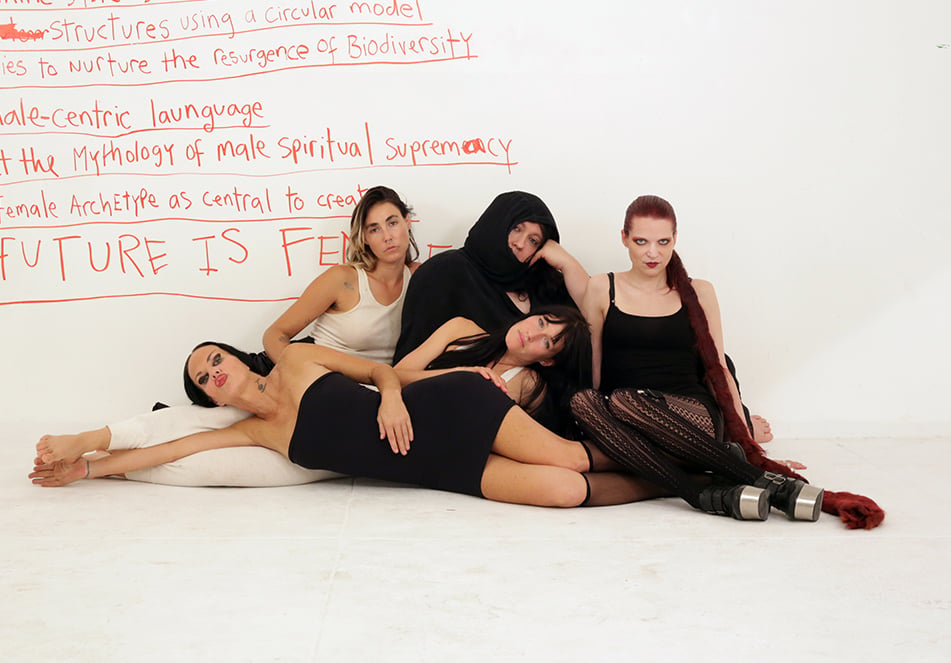
Anohni and her feminist collaborators are staging a second exhibition and workshop series for a better, and more feminine, future.

Alyssa Buffenstein

In her first public address after Donald Trump’s inauguration, Hillary Clinton spoke the phrase “The future is female,” a catchy, viral slogan that had made its way onto t-shirts and picket signs worldwide. While the New York Times has traced the phrase back to 1975, one group of artists claim to have brought it back into contemporary circulation, beginning with a 2014 exhibition and event series in New York City under the moniker of “Future Feminism.”
The exhibition was the culmination of more than three years of discussion-filled retreats taken by the artists and musicians Anohni, Kembra Pfahler, Johanna Constantine, and CocoRosie’s Bianca and Sierra Casady. The longtime peers spent hours sharing art ideas and comparing notes, eventually distilling them all into “13 Tenets of Future Feminism,” with “The Future is Female” as the final tenet. The exhibition was accompanied by a 13-day festival with performances, talks, and workshops by artists like Laurie Anderson, Juliana Huxtable, and Marina Abramović. Now, three years later, Future Feminism is getting a reprise, this time hosted in a less-expected city in Denmark.
Aarhus, Denmark is the 2017 European Capital of Culture, and for the year, Anohni is the city’s resident artist. From August 11 to September 3, she is using the opportunity to bring Future Feminism to Scandinavia. In advance of the exhibition and series of performances, workshops, and discussions, Anohni and Pfahler spoke with artnet News over Skype about the origins of Future Feminism, and what’s in store for its European debut.

Installation view of the 2014 ‘Future Feminism’ exhibition at the Hole in New York City. Image courtesy the Hole.
Before writing the 13 tenets, which were eventually etched into slabs of pink marble as artworks, the artist-collaborators had circled around each other as friends and peers for years. Anohni is best known for her career in pop music, using dreamy, soulful sounds to advance ideas of social justice. For example, the 2016 song “Drone Bomb Me,” which appeared on Anohni’s first solo album, Hopelessness, was written from the perspective of a fictional, young Afghani girl, whose family was killed by drone strikes, and who, in desperation, longs to be killed the same way. A transgender woman, Anohni first rose to fame as the frontperson of musical group Antony and the Johnsons.
Pfahler is a subversive performance artist known for her extreme style, most often associated with fronting in the shock-rock band The Voluptuous Horror of Karen Black, appearing wearing little else but body paint, thigh-high boots, and a comically voluminous wig. In the early 90s in New York City’s Lower East Side, they worked together in the Blacklips Performance Cult, a collective dedicated to experimental theater that bore the unmistakable aesthetic of the New York City club kid. Johanna Constantine, a Future Feminism collaborator, was also a founding member. Rounding out the core group of Future Feminists are sisters Bianca and Sierra Casady.
Despite knowing each other for years, Anohni says they had “never actually tried to cross-pollinate and find consensus amongst ourselves.”
“At a certain point I suggested we all get together and start comparing notes, thinking that maybe collectively, we would have more agency than we did individually,” she continued.
“It was more like brainstorming, co-authorship, trying to really excavate and come up with new ideas during very lengthy conversations. It was the first time I had ever participated in that kind of discussion group. It was really life-changing, it was extreme, cathartic, and wonderful,” Pfahler added.
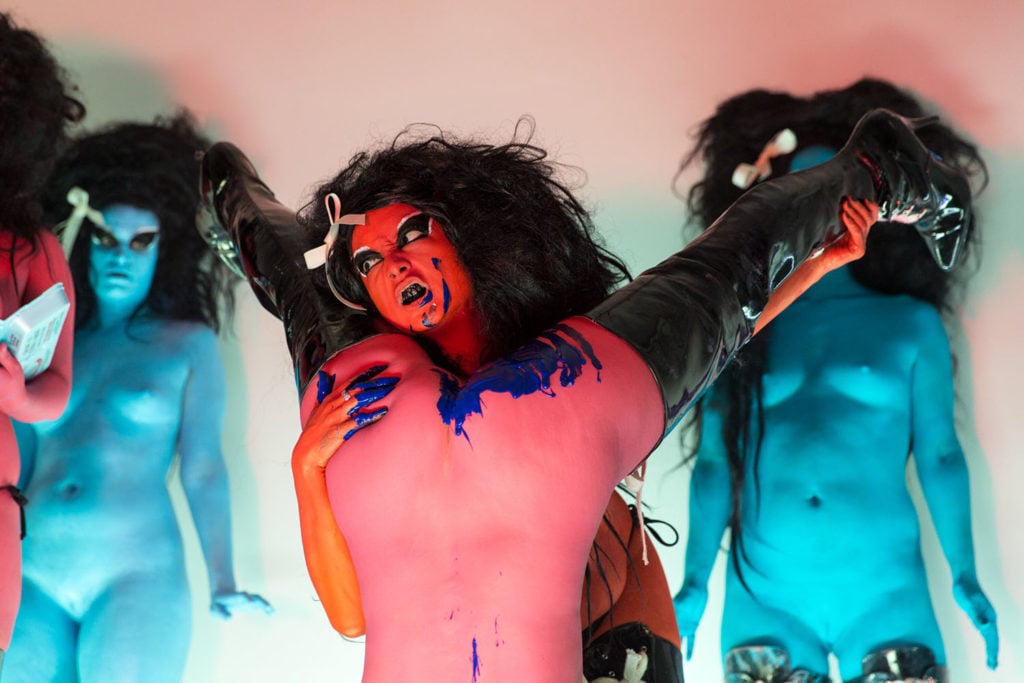
Kembra Pfahler and the Girls of Karen Black performing at the Hole NYC in 2014. Image courtesy the Hole NYC.
Anohni explains that she first began to use the term “future feminism” to describe Pfahler’s and Constantine’s work. For the group, it came to mean “feminists who are preoccupied with the future,” and, importantly, not a term that marked the group as the self-proclaimed prophets of the future of feminist ideology.
The tenets have a distinctly eco-feminist slant, beginning with number one: “The subjugation of women and the Earth are one and the same,” calling for a future that could liberate both, by means of, for starters, “[enforcing] a global standard for the rights and ethical treatment of women,” “[redefining] the societal roles of women and men in response to present conditions,” and “[feminizing] male-centric language.”
“Part of [the project] was a challenge to ourselves to issue a radical prescription for hope, what hope would look like; what would the criteria be to create a more sustainable relationship to our planet, such that life could continue to proliferate? The idea was to change tracks onto a less death-oriented trajectory as a species,” said Anohni.
One idea that arose during the conversations was that women, no matter where they fall on the gender spectrum, have certain traits in common that have been historically stigmatized, but could actually be huge assets to putting the world on a less destructive track.
“We believe that women have more access to archetypally feminine skill sets encouraged by their biologies and experiences, making them uniquely qualified as a group to explore a sustainable way forward,” Anohni said in a press release for the exhibition.
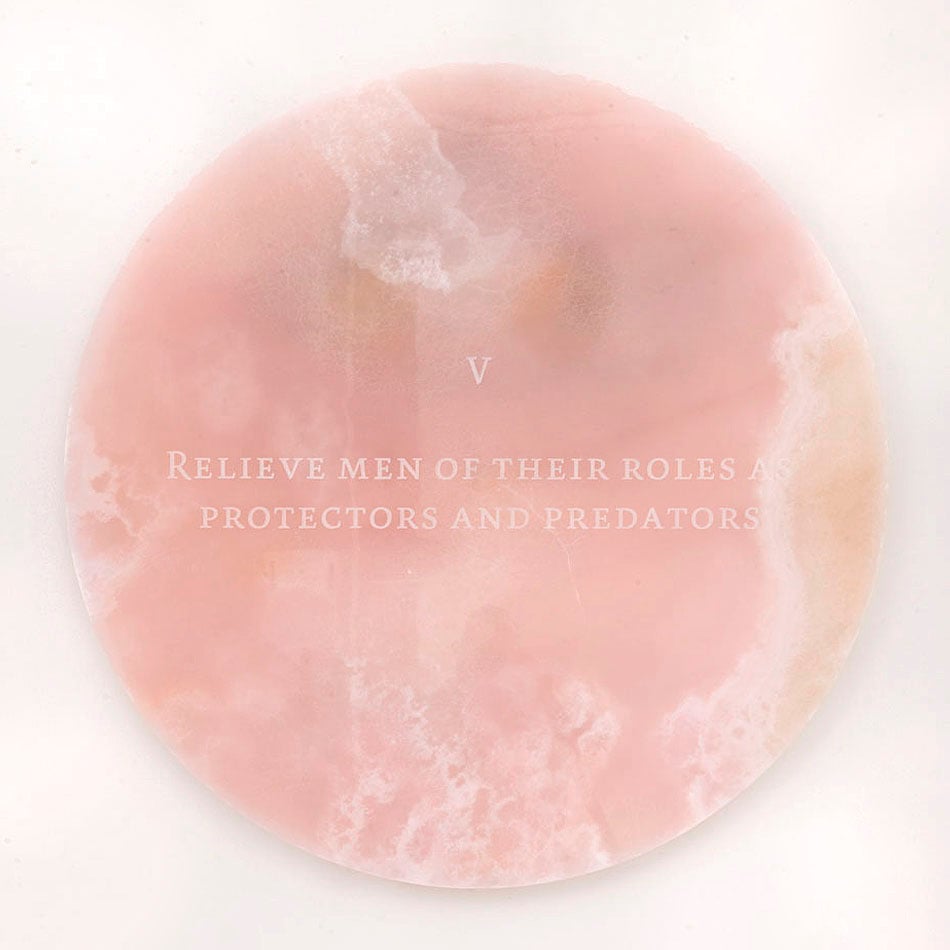
The fifth tenet of Future Feminism. Image courtesy the Hole NYC.
Speaking to artnet News on the topic, Anohni approaches with caution and many caveats, careful not to say anything that might cancel out any individual’s experience with gender identity. She and Pfahler explain that the Future Feminists have been met with criticism in the past by other feminist groups who viewed them as “essentialist.” (Essentialism, in the world of gender studies, is the idea that women have certain fixed traits, tied to biology. This can be controversial among certain people who believe that gender is a social construct, or that gender is more fluid than a male-female binary.)
“For me, as a transperson, I’m so excruciatingly aware of how biology does affect gender, but each of us within our own sphere is dealing with identity issues, particularly of femininity and of archetypes of femininity,” Anohni said.
“It’s been a little bit treacherous […] to assert that there are some core values that are, in our poetic minds, associated with the feminine archetype, and that they are useful; that there is a skill set that is biologically imbued in half the members of the human race that is wildly under-utilized, that has been subjugated, suppressed, and divided and conquered. It is those ideas that we sometimes shirk from as feminists: the idea that we are more emotional, more empathetic, more intuitive. All of those stereotypes that have been used to disqualify us from seats in governments are actually assets that might be totally redemptive, that could help save life on earth,” she continued.
Pfahler felt that the criticisms boiled down to aesthetic differences, and cited a lesson she learned from a former teacher, Lorraine O’Grady, during O’Grady’s performance at the 2014 exhibition: “Her main point was that there’s room for all sorts of feminisms in this world.”
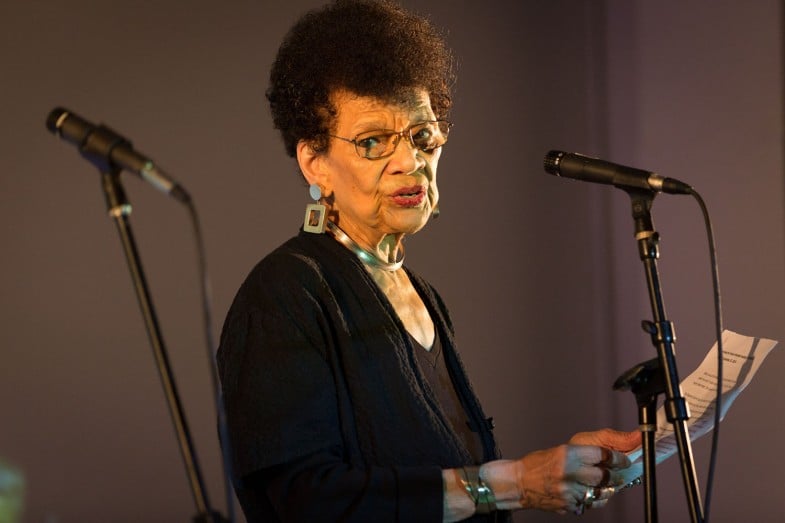
Lorraine O’Grady at the 2014 Future Feminism exhibition. Image courtesy the Hole NYC.
In Aarhus, Future Feminism will make a priority of engaging with the local community. “Because it’s a different country,” Anohni says, “We’re trying to mold the conversations to be a catalyst to help local people address issues that are in their minds.” Despite being literally carved in stone, the tenets are mutable, Anohni explains, emphasizing that they are “13 tenets, not the 13 tenets,” and that they should not be taken as gospel. So naturally, Future Feminist events are more about sharing knowledge than they are about driving home an ideology to a passive audience.
Each day, there will be a tea with invited scholars, community leaders, and artists, to discuss one of the existing tenets. Other events include one that will bring together the eldest women of the city to discuss their perception of the last 100 years of life for women in the region, how it’s transformed, and what they think the future might bring. Another panel will feature first-generation immigrants and refugees living in Denmark, giving them a platform to express their thoughts and needs. Additionally, members of Sweden’s Feminist Initiative, one of the world’s only currently successful feminist political parties, will discuss their platform alongside activists trying to start a similar party in Denmark. And a group of environmentalists have also been invited, in Anohni’s words, “to try to better understand a mutual language that feminists and environmentalists can share.”
A number of workshops will put theory into practice, including one led by protest group FEMEN—whose approach Anohni likens to the work of Pfahler and Constantine. Despite FEMEN’s divisiveness, Anohni describes their work as “courageous feminism, utilizing women’s bodies as a front line or a shield.”
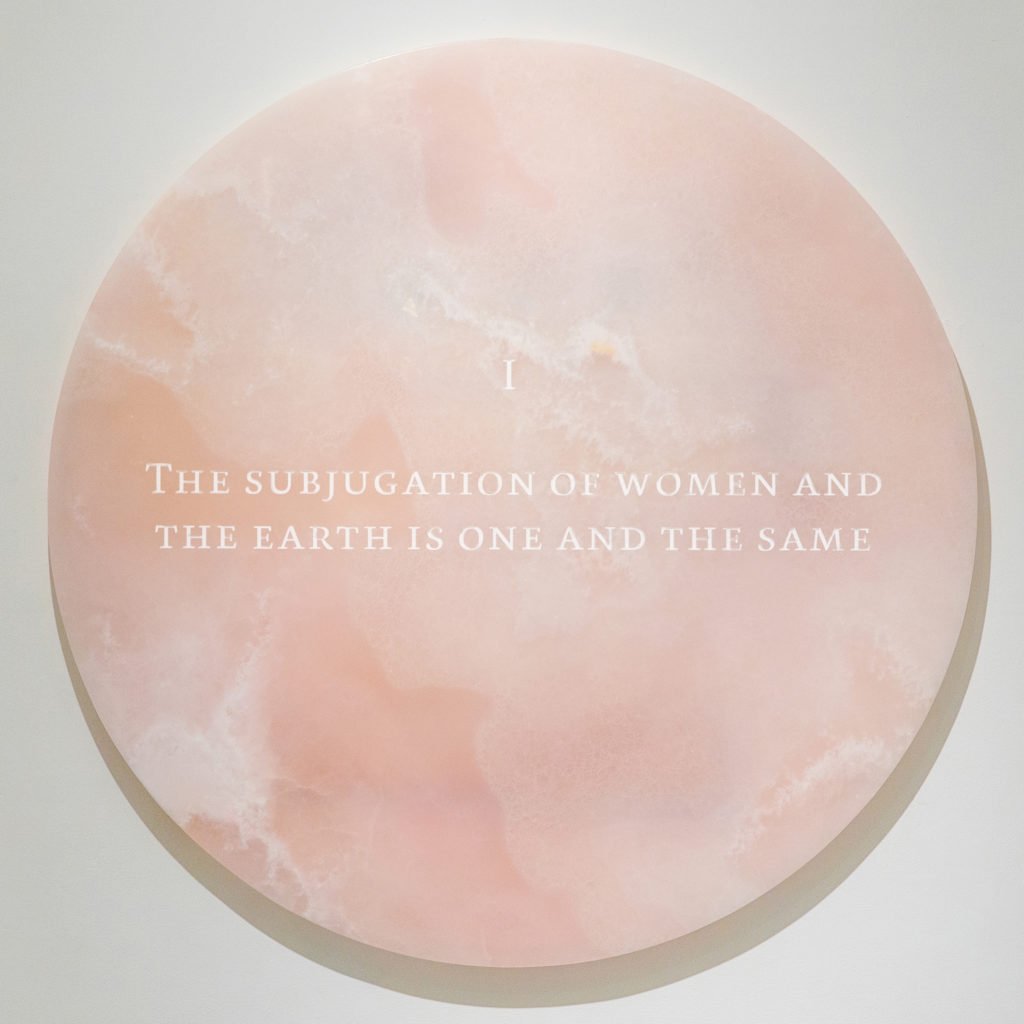
The first tenet of Future Feminism. Photo courtesy Anohni/Aarhus 2017 European Capital of Culture.
Part of the exhibition will be dedicated to a friend and important collaborator who worked with the group for the 2014 exhibition, who was murdered in a case of domestic violence. In her memory, there will be a series of self-defense training workshops open to people of all ages.
Pfahler will also teach her workshop, “Performance Art 101,” open to people of all experience levels, and culminating in performances at the gallery.
“Future Feminism” will take place at Gallery ‘O’ Spacein Aarhus, Denmark from August 11 to September 1, 2017.
To apply for Kembra Pfahler’s Performance Art 101, send an email to: [email protected].